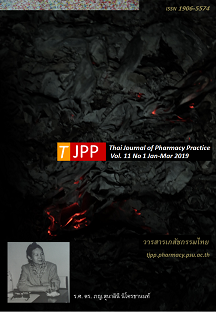การพัฒนาแบบประเมินคุณภาพแอปพลิเคชันทางสุขภาพของไทย
Main Article Content
บทคัดย่อ
วัตถุประสงค์: เพื่อพัฒนาแบบประเมินคุณภาพแอปพลิเคชันทางสุขภาพบนโทรศัพท์มือถือของไทย หรือ Thai Mobile Health Apps Rating Scale (THARS) และตรวจสอบความเที่ยงและความตรงของแบบประเมินที่พัฒนาขึ้น วิธีการ: ใช้การทบทวนวรรณกรรมอย่างเป็นระบบเพื่อหาข้อสรุปของเกณฑ์การประเมินคุณภาพแอปพลิเคชันทางสุขภาพบนโทรศัพท์มือถือให้ครอบคลุม ผู้วิจัยนำประเด็นที่รวบรวมได้สร้างคำถามเป็นแบบประเมิน THARS version 1 การทดสอบความตรงเชิงเนื้อหาและความตรงเชิงพินิจ (face validity) ทำโดยการตรวจสอบของผู้เชี่ยวชาญ 3 ท่าน จากนั้นปรับปรุงแบบประเมินอีกครั้งได้เป็น THARS version 2 และได้รับการประเมินความตรงเชิงพินิจจากผู้ใช้แอปพลิเคชันทางสุขภาพบนโทรศัพท์มือถือ 10 คน จากนั้นทดสอบหาความเที่ยงโดยการวัดความสอดคล้องภายในและการวัดแล้ววัดซ้ำในตัวอย่างจำนวน 150 คนที่ใช้งานแอปจำนวน 2 แอป และประเมินแอป 2 ครั้งด้วย THARS version 3 แต่ละครั้งห่างกัน 14 วัน หลังจากนั้นนำคะแนนที่ได้มาหาค่าสัมประสิทธิ์แอลฟาและค่าสหสัมพันธ์ภายในชั้น ผลการวิจัย: การทบทวนวรรณกรรมอย่างเป็นระบบ พบการประเมินคุณภาพแอปพลิเคชันใน 15 ประเด็นจากการศึกษาทั้งหมด 66 เรื่อง การทดสอบความตรงเชิงเนื้อหาของ THARS verson 1 ได้ค่าดัชนีความตรงเชิงเนื้อหารายข้อ (I-CVI) ตั้งแต่ 0.3-1 และได้ค่าดัชนีความตรงเชิงเนื้อหาภาพรวมของทั้งฉบับ (S-CVI) 0.9 การปรับปรุงแบบวัดทำให้ได้ THARS version 2 และ 3 ซึ่งมีข้อคำถาม 38 ข้อ ค่าสัมประสิทธิ์แอลฟาของ THARS version 3 มีค่า 0.76 ถึง 0.83 ค่าสหสัมพันธ์ภายในชั้น (95%CI) ของคะแนนรวม 2 ครั้งในการประเมินแอปทั้ง 2 แอปได้ค่า 0.84 (0.78-0.88) และ 0.94 (0.91-0.96) สรุป: THARS มีความตรงอยู่ในระดับดี มีความสอดคล้องภายในระดับยอมรับได้ และมีความเที่ยงในระดับดีเยี่ยม ซึ่งสามารถนำไปใช้ในการประเมินคุณภาพแอปพลิเคชันทางสุขภาพของไทยได้
Article Details
ผลการวิจัยและความคิดเห็นที่ปรากฏในบทความถือเป็นความคิดเห็นและอยู่ในความรับผิดชอบของผู้นิพนธ์ มิใช่ความเห็นหรือความรับผิดชอบของกองบรรณาธิการ หรือคณะเภสัชศาสตร์ มหาวิทยาลัยสงขลานครินทร์ ทั้งนี้ไม่รวมความผิดพลาดอันเกิดจากการพิมพ์ บทความที่ได้รับการเผยแพร่โดยวารสารเภสัชกรรมไทยถือเป็นสิทธิ์ของวารสารฯ
เอกสารอ้างอิง
2. Juan MG-G, Isabel de la T-D, Javier V, Montserrat R, Miguel L-C, Joel JR. Analysis of mobile health applications for a broad spectrum of consumers: A user experience approach. Health Informatics J. 2014; 20: 74-84.
3. Internet Society APAC Bureau. Mobile internet usage trend in Asia-Pacific 2016 [online]. 2016 [cited Mar 29, 2017]. Available from: www.internet society.org/wp-content/uploads/2017/08/Mobile20In ternet20Usage20Trends20in20Asia-Pacific.pdf.
4. MobiHealthNews. US regulators remove two acne medical apps [online]. 2011 [cited Sep 9, 2017]. Available from: www.mobihealthnews.com/13123/u s- regulators-remove-two-acne-medical-apps.
5. Cortez NG, Cohen IG, Kesselheim AS. FDA regulation of mobile health technologies. N Engl J Med 2014; 371: 372-9.
6. Stoyanov SR, Hides L, Kavanagh DJ, Zelenko O, Tjondronegoro D, Mani M. Mobile app rating scale: a new tool for assessing the quality of health mobile apps. JMIR Mhealth Uhealth 2015; 3: e27.
7. Stoyanov SR, Hides L, Kavanagh DJ, Wilson H. Development and validation of the user version of the mobile application rating scale (uMARS). JMIR Mhealth Uhealth 2016; 4: e72.
8. Polit DF, Hungler BP. Nursing research principles and methods. 6th ed. Philadelphia: Lippincott Will iams & Wilkins; 1999.
9. Anthoine E, Moret L, Regnault A, Sébille V, Hardouin J-B. Sample size used to validate a scale: a review of publications on newly-developed patient reported outcomes measures. Health Qual Life Outcomes 2014; 12: 30-46.
10. Ventola CL. Mobile devices and apps for health care professionals: uses and benefits. P T 2014; 39: 356-64.
11. BinDhim NF, Hawkey A, Trevena L. A systema tic review of quality assessment methods for smart phone health apps. Telemed J E Health 2015; 21: 97-104.
12.Liberati A, Altman DG, Tetzlaff J, Mulrow C, Gøt zsche PC, Ioannidis JPA, et al. The PRISMA state ment for reporting systematic reviews and meta-analyses of studies that evaluate healthcare interventions: explanation and elaboration. BMJ 2009; 339: b2700.
13. Polit DF, Beck CT. The content validity index: Are you sure you know what's being reported? Critique and recommendations. Res Nurs Health 2006; 29: 489-97.
14. Nunnally JC. Psychometric theory. 2nd ed. New York: McGraw-Hill; 1978.
15. Devellis RF. Scale development theory and app lications. 4th ed. California: Sage; 2017.
16. Punyapas S, Pornnoppadol C, Boonyasidhi V, Likhitkiatikhachorn P. Reliability and validity of Weiss Functional Impairment Rating Scale (WFIR S)-Thai version in children and adolescents with attention deficit hyperactivity disorder. J Psychiatr Assoc Thailand 2015; 60: 111-26.
17. Ferketich S. Focus on psychometrics: aspects of item analysis. Res Nurs Health. 1991; 14: 165-8.
18. Pallant J. SPSS Survival Manual: A step by step guide to data analysis using SPSS for Windows version 15. Milton Keynes: Open University Press; 2007.
19. Koo TK, Li MY. A Guideline of selecting and reporting intraclass correlation coefficients for reliability research. J Chiropr Med 2016; 15: 155-63.
20. Hallgren KA. Computing inter-rater reliability for observational data: An overview and tutorial. Tutor Quant Methods Psychol 2012; 8: 23-34.
21. Parsian N, Dunning T. Developing and validating a questionnaire to measure spirituality: a psycho metric process. Glob J Health Sci 2009; 1: 2-11.
22. Streiner DL, Norman GR, Cairney J. Health measurement scales: A practical guide to their development and use. 5th ed. Oxford: Oxford University Press; 2014.
23. Keszei AP, Novak M, Streiner DL. Introduction to health measurement scales. J Psychosom Res 2010; 68: 319-23.
24. Cho MJ, Sim JL, Hwang SY. Development of smartphone educational application for patients with coronary artery disease. Healthc Inform Res 2014; 20: 117-24.
25. de la Vega R, Roset R, Castarlenas E, Sánchez-Rodríguez E, Solé E, Miró J. Development and testing of painometer: A smartphone app to assess pain intensity. J Pain 2014; 15: 1001-7.
26. Stinson JN, Jibb LA, Nguyen C, Nathan PC, Maloney AM, Dupuis LL, et al. Development and testing of a multidimensional iPhone pain assess ment application for adolescents with cancer. J Med Internet Res 2013; 15: e51.
27. Baumel A, Faber K, Mathur N, Kane JM, Muench F. Enlight: A comprehensive quality and therapeu tic potential evaluation tool for mobile and web-based eHealth interventions. J Med Internet Res 2017; 19: e82.


